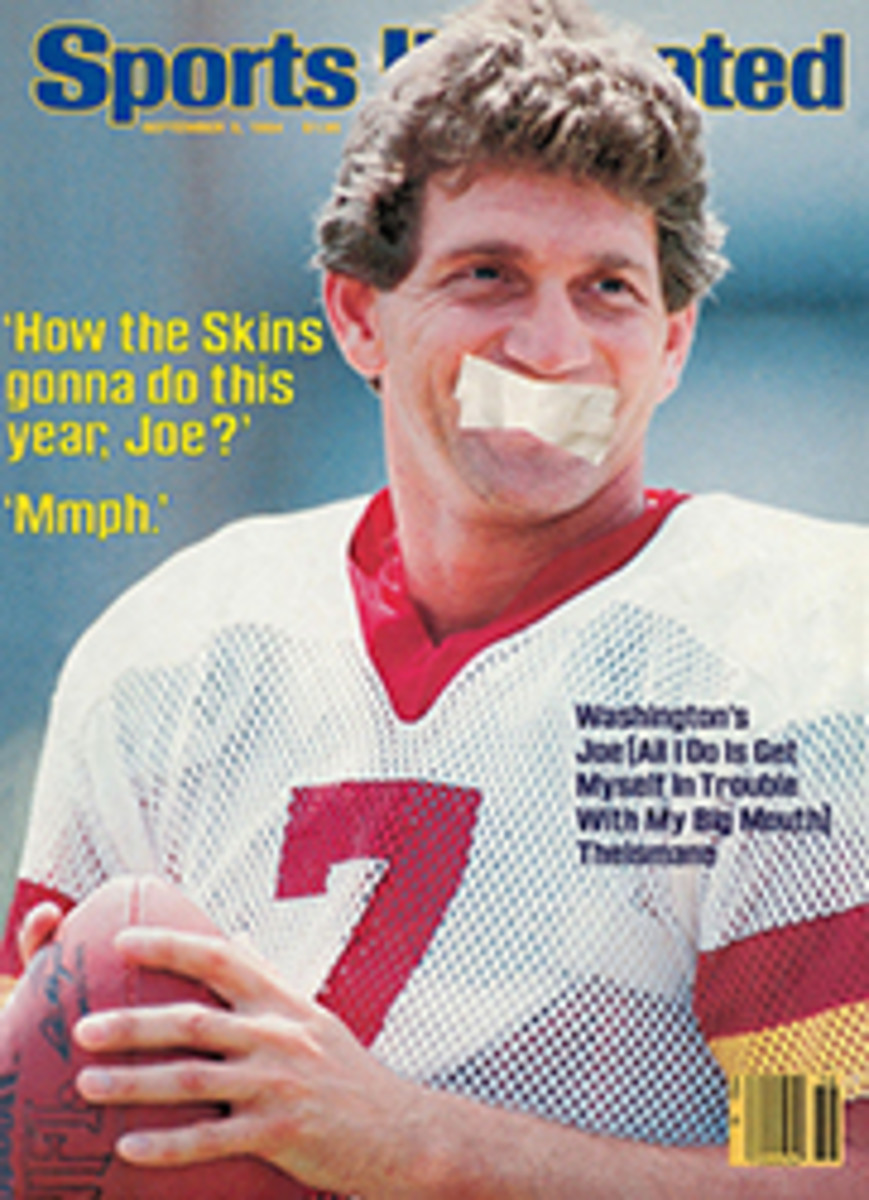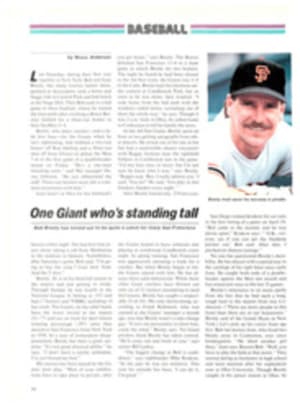
EXTRA POINTS
The word around the NFL is that Franco Harris is past his prime, not worth the $385,000 base salary he was to have made this season and certainly not the $560,000 the Steelers reportedly offered in order to keep him for 1984.
Says one G.M., "The Steelers were doing Franco a favor by even considering paying him more money. He started out strong at the beginning of last season, then petered out. He's burned out. Who needs him? Franco's like a lot of older pro athletes—greedy in his old age. He hasn't invested as well as he could have, and he needs the money. The Steelers couldn't let sentimentality stand in the way of their future."
During the negotiations, Bart Beier, Harris's agent, admitted, "Franco's past business ventures aren't very good." But later, Beier backpedaled, saying, "I haven't represented him long enough to really comment."
Whatever Franco's business acumen, one thing is certain: He vastly overestimated his worth to the Steelers, who are rebuilding and would rather go with young backs such as 11th-round pick Elton Veals. The 34-year-old Harris no doubt figured he could push the Steelers to the brink because of the publicity he was generating in his chase of Jim Brown's career rushing record. Harris needs just 363 yards to become the NFL's alltime leading ground gainer.
But, as another G.M. pointed out, "The Steelers have been a part of so many records, what's one more?"
Late in negotiations Harris said he'd take the $560,000 deal, which included an option year for a 10% raise ($616,000), only if the Steelers would tell him within two weeks of the end of the '84 season if he figured in their plans for '85. If not, Harris wanted to be free next spring to extend his career in the USFL. The Steelers met that condition.
Then Harris went too far. He demanded that the Steelers—if they decided to bring him back in '85—pay him a portion of his $616,000 salary for that year up front. That way, Harris would get some cash for '85 even if the Steelers cut him in training camp. Pittsburgh said no and put him on waivers.
Raider All-Pro defensive end Howie Long, who stalked out of camp for four days this summer demanding "Gastineau money" ($750,000) rather than the $175,000 his contract called for, recently bought a $1 million insurance policy from Lloyd's of London to guard against injury while he's in contract renegotiations. The policy cost him $10,000.
Bronco coach Dan Reeves is getting heat about his choice at quarterback and his zillions-of-variations-on-a-theme offense, both of which seem to be set in stone.
John Elway was inconsistent in the first two preseason games, while backup Gary Kubiak was 22 of 30 for 253 yards and one TD. Elway finally showed his golden arm in Game 3, a 31-0 rout of the Colts, completing 18 of 29 for 240 yards and three touchdowns. Last week he completed 15 of 25 for 152 yards and another TD in a 24-13 win over Atlanta.
Elway's No. 1, but the jury's still out. Says one Bronco, "I won't be convinced until I'm sure John has stopped believing he's Superman and starts working on learning the game plan. He must be the only starting NFL quarterback who didn't stay in his team's town and work out in the off season. He has to stop thinking he can just wing it out there."
And the motion offense? Well, it may be working against the Broncos. Tight end Eason Ramson, who was traded to Denver by the 49ers and is now on injured reserve, has told his old teammates that Reeves's offense is "too confusing." Another Bronco says, "There's no rhyme or reason to it. It's all memorization." And 49er cornerback Ronnie Lott adds, "If Elway played in our system, he'd be one of the leaders in passing."
"I guess I'm not flashy enough," William Andrews, the Falcons' All-Pro running back, has said repeatedly during his five-year career. "I'm legitimate, though. My peers know that, even if the public doesn't."
Andrews, who has outgained all other NFL backs rushing and receiving (8,384 yards) since he was a third-round pick out of Auburn in '79, is the most underrated player in the league. He's one of only three backs in NFL history—the others are O.J. Simpson and Walter Pay-ton—to twice gain more than 2,000 yards rushing and receiving in a season. Andrews had 2,037 yards in '81 and 2,176 in '83.
"Every year there was a hotshot rookie, or a Sweetness [Payton] or a Tony D, who beat me out for the rushing title," Andrews said. "I'm just plain old William. Maybe if I was 'Billy Andrews' I'd be on the tips of people's tongues."
Unfortunately, it has taken a severe season-ending—and maybe career-ending—knee injury for Andrews to get attention. Cutting upfield on a routine right sweep in practice last week, he hyperextended his left knee, tearing the posterior and anterior cruciate ligaments and rupturing the lateral ligament complex. When Andrews said his leg felt "asleep," it was feared he had also severed the peroneal nerve, which runs around the outside of the knee and controls the upward movement of the foot and toes. If so, he might never have walked normally again.
Dr. John Garrett, Falcon orthopedic surgeon, said that while the nerve was "in continuity," it would be at least six months before he'd know if it would heal properly. He said he was "optimistic" about Andrews' return but he predicted at least a year of rehabilitation.
Raider linebacker Matt Millen spotted something a couple of weeks ago while studying films of the Dolphins: Fernanza Burgess, a free agent receiver from Morris Brown College, delivers a mean crack-back block. Millen didn't like what he saw, and he liked it even less when he saw it Aug. 19 in the first half of the Raiders' game against Miami. Repeatedly, Burgess went in motion, doubled back along the line of scrimmage and blind-sided L.A. linebackers.
As the teams left the field at halftime Millen screamed at Miami coach Don Shula, "If you send that guy at me like that again, I'll break his neck."
On the first play of the second half, Burgess went directly for Millen, who was waiting. Millen hammered Burgess with a forearm, and, for good measure, cornerback Lester Hayes jumped on Burgess's back. Shula figured that might happen, so he had called a hand-off to running back Joe Carter, who shot through the hole created by Millen's absence and ran for 56 yards.
The next day Shula watched that play on film with some amusement, but Burgess's crackback blocking wasn't always so funny. Later in the game he blind-sided reserve linebacker Jack Squirek, breaking the Raider's jaw in two places and knocking him out of action for at least six weeks.
"When we play them again [Dec. 2]," Millen said, "there'll be a new term introduced—intensity."
DIAGRAM
WS
C
WR
SS
TE
TB
TE
B
E
B
T
N
B
E
B
TE
C
PHOTO
Three generations of Shulas—Don, Danny and David—know that Granddad isn't always gruff.
FOUR ILLUSTRATIONS
HERE'S A NEW WAY TO ACE OUT THE DEFENSE
You've been seeing a lot of the Ace or H (one-back) formation in recent years, especially from the Falcons, Redskins and Rams. Now, from the drawing board of San Diego's Don Coryell, the coach who reintroduced the one-back offense to the NFL in 1980, there's a refinement of the Ace: the three-tight-end offense.
One wide receiver and one back come out of the game and are replaced by larger tight ends. The defense reads this as RUN, although it can't overlook the Chargers' remaining wide receiver (Ace wide receiver?), especially when that wideout's Wes Chandler.
Coryell usually sets two tight ends on the line, splits the third left or right and keeps one back in the back-field. But on some plays (above), the third tight end lines up as the fullback. The quarterback pitches to the tailback, and the tight end leads the tailback out of the backfield and blocks the strong safety.
The Chargers have three excellent tight ends in Kellen Winslow (6'5", 251); Eric Sievers (6'4", 233); and Pete Holohan (6'4", 240). "What makes this formation so revolutionary is that we'll use three tights in normal down-and-distance situations, not just on the goal line," says Charger assistant head coach Ernie Zampese. "We're about the only team that can do this because I don't know anybody in the NFL who has three tight ends they'd want to play all the time."
LIKE FATHER, LIKE SON FOR THESE DOLPHINS
Miami coach Don Shula, 54, was discussing the traits he shares with his oldest son, David, 25, the team's receiver coach.
"Our energy is limitless," Don said. "We're both driven. We refuse to be licked...."
David, who was listening from the other side of the room that he and his dad share at training camp, interrupted.
"Stubborn!" he shouted.
"Stubborn?" Don said. "I'm not stubborn."
"We're both stubborn, Dad," David said.
In December '82, Dolphin assistant Wally English left to take the head job at Tulane, and Don asked David, who was home from his first semester of law school at the University of Baltimore, to fill in "for a couple of weeks...doing basic breakdowns of films."
David, who grew up cleaning Larry Csonka's cleats and had played one year with the Colts after a successful career as a receiver at Dartmouth, has turned out to be one of Don's greatest finds. By last season, he had transformed a raw Mark Duper into Super Duper—the first Dolphin receiver to gain more than 1,000 yards. This summer his big project was barn burner Mark Clayton. Clayton is a good bet to start at the other wideout when he recovers from a hip pointer.
David is also credited with the Mellowing of Don. "My father has learned to laugh and not to be so tunnel-visioned," David said. "Actually, Danny Shula's the guy who mellowed him."
Danny is the 10-month-old son of David and his wife, Leslie, and the first grandchild of Don and his wife, Dorothy.
"After practice every day, Leslie brings Danny to my office so David can feed him," says Grandpa. "And I talk baby talk to Danny. That'll ruin my reputation, but it's sure a lot of fun."

